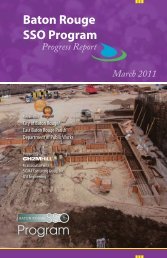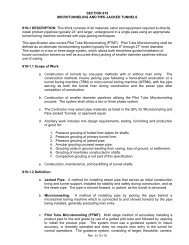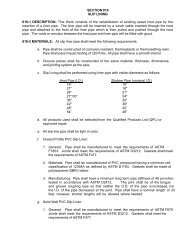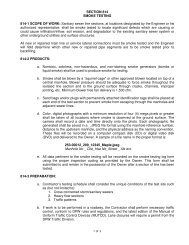Contents
Construction Management Plan - Baton Rouge Department of Public ...
Construction Management Plan - Baton Rouge Department of Public ...
- No tags were found...
Create successful ePaper yourself
Turn your PDF publications into a flip-book with our unique Google optimized e-Paper software.
• Maintain safe distance from operating equipment and stay alert of equipment movement.<br />
Avoid positioning between fixed objects and operating equipment and equipment pinch points,<br />
remain outside of the equipment swing and turning radius. Pay attention to backup alarms, but<br />
not rely on them for protection. Never turn your back on operating equipment.<br />
• Approach operating equipment only after receiving the operator’s attention. The operator shall<br />
acknowledge your presence and stop movement of the equipment. Caution shall be used when<br />
standing next to idle equipment; when equipment is placed in gear it can lurch forward or<br />
backward. Never approach operating equipment from the side or rear where the operator’s<br />
vision is compromised.<br />
• When required to work in proximity to operating equipment, wear high-visibility vests to<br />
increase visibility to equipment operators. For work performed after daylight hours, vests shall<br />
be made of reflective material or include a reflective stripe or panel.<br />
• Do not ride on earthmoving equipment unless it is specifically designed to accommodate<br />
passengers. Only ride in seats that are provided for transportation and that are equipped with<br />
seat belts.<br />
• Stay as clear as possible of all hoisting operations. Loads shall not be hoisted overhead of<br />
personnel.<br />
• Earthmoving equipment shall not be used to lift or lower personnel.<br />
• If equipment becomes electrically energized, personnel shall be instructed not to touch any part<br />
of the equipment or attempt to touch any person who may be in contact with the electrical<br />
current. The utility company or appropriate party shall be contacted to have line de-energized<br />
prior to approaching the equipment.<br />
2.2.11 Electrical<br />
(Reference CH2M HILL SOP HS-206, Electrical)<br />
• Only qualified personnel are permitted to work on unprotected energized electrical systems.<br />
• Only authorized personnel are permitted to enter high-voltage areas.<br />
• Do not tamper with electrical wiring and equipment unless qualified to do so. All electrical<br />
wiring and equipment must be considered energized until lockout/tagout procedures are<br />
implemented.<br />
• Inspect electrical equipment, power tools, and extension cords for damage prior to use. Do not<br />
use defective electrical equipment, remove from service.<br />
• All temporary wiring, including extension cords and electrical power tools, must have ground<br />
fault circuit interrupters (GFCIs) installed.<br />
• Extension cords must be:<br />
− Equipped with third-wire grounding.<br />
− Covered, elevated, or protected from damage when passing through work areas.<br />
− Protected from pinching if routed through doorways.<br />
− Not fastened with staples, hung from nails, or suspended with wire.<br />
• Electrical power tools and equipment must be effectively grounded or double-insulated UL<br />
approved.<br />
• Operate and maintain electric power tools and equipment according to manufacturers'<br />
instructions.<br />
A-18 GNV310133632156.DOC/090840008












